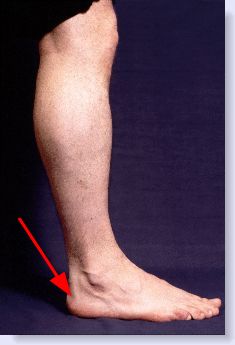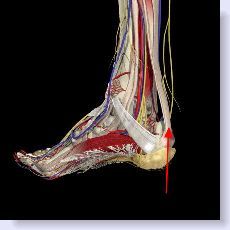posterior heel pain
AUTHOR: Marc Mitnick DPM home --> heel pain --> posterior heel painThe second area where people experience heel pain is on the back of the heel. Although there can be a connection between pain on the bottom and back of the heel, the causes of posterior heel pain generally differ from that of plantar heel pain.
PUMP BUMP
The most common cause of pain in the back of the heel that I see is generally referred to as pump bump also known as Haglund's deformity.
symptoms of pump bump
- Typically a woman, less frequently a man, will present to the office complaining of a sharp pain on the back of the heel just slightly off the center.
- There will be no history of trauma, although the patient may be required to do a lot of walking in a dress shoe.
- This posterior heel pain will be at its worst when in dress shoes.
- May be less painful in sneakers and may be hardly noticeable when barefoot.
- Examination of the back of the heel will reveal a slightly enlarged area that may be slightly red in color and usually very painful to touch.
Not coincidentally, you will notice that the top of the patient’s dress shoe just happens to cut across the heel at that level.
What has happened is that through constant wearing of dress shoes, the shoe itself has irritated the underlying bone, the bone has slightly enlarged as a result of that irritation and in an effort to protect the area of irritation, the body has formed a bursal sac which itself has become inflamed and is now a bursitis.
- In most cases, an x-ray of the heel will reveal an enlarged section of the heel bone (calcaneus).
Below is the usual site for a ‘pump bump’ or bone spur with bursitis.

|
treatment of pump bump
The obvious treatment for this type of posterior heel pain would be to avoid wearing the shoes that aggravate the problem; that is easier said than done. I have been in this business long enough to know that a fashionable woman is going to continue to wear the shoes that look the best even though they might not feel the best.
That said, sometimes adding a small heel lift to the shoe will help as it may raise the heel just enough so that the top back portion of the shoe does irritate the enlarged bone and bursal sac.
If the area is not too inflamed and painful, one may try some of the new gel cushions that are available in an effort to reduce friction.
From a medical stand point, short term anti-inflammatory medication may help but of course will not cure if the shoe is still irritating the area.
Cortisone injection many times is very helpful, the key is to inject just under the skin and avoid the Achilles tendon which can weaken from this type of injection.
Physical therapy is also very helpful in alleviating this type of pain.
Surgical intervention should be considered in instances where conservative measures fail. In this case, the overgrowth of bone is removed as well as the overlying bursitis. This is usually reserved for people who have stopped wearing the shoes that originally caused the problem, but are still having posterior heel pain nonetheless. Unfortunately, many foot problems can continue to be bothersome even when the causative agent is identified and removed. (Once you have it; you have it!)
ACHILLES TENDONITIS
The other type of posterior heel pain that we see involves irritation of the Achilles tendon. The cause of this irritation may be due to trauma directly to the tendon, overuse of the tendon which is particularly a problem in men over the age of 40 who continue to play a lot of sports. People who have a tight heel cord, whereby it is very difficult to raise the foot at the level of the ankle, are more prone to Achilles tendon problems.
Below is a picture of the Achilles tendon.

|
The patient will present with tenderness and possibly swelling in the area of Achilles tendon anywhere from where it attaches into the heel bone to just above the ankle. An x-ray may also reveal the formation of bone spurs at the level where the tendon attaches into the heel. The spurs can become painful if they are irritated enough. Further complicating the situation is the fact that there is a natural occurring bursal sac that sits between the heel bone and Achilles tendon which may also become inflamed and painful in the process.
If there has been trauma to the area it is important make sure all or part of the tendon has not torn. You should see a doctor right away, even though you may be able to walk, you may still have a partial tear. A torn Achilles tendon is a very debilitating condition.
Icing the area for 24 hours can be very helpful as well as anti-inflammatory medication. Rest would also be advised. I am not big on ice after 24 hours; I generally switch my patients to heat in an effort to increase blood flow to the area to enhance the healing.
If the Achilles tendon has been strained rather than traumatized, the above applications apply. Adding a one quarter inch heel lift can be of benefit because it will shorten the tension on the heel cord especially in those who exhibit a tight Achilles tendon. If the strain is severe enough immobilization of the ankle may be necessary.
see related article....Achilles tendonitis
PLANTARIS TENDONITIS
This condition is more of a board question than a medical problem seen in any frequency. The plantaris tendon travels down the back of the leg and runs parallel and medial to the Achilles tendon. Its insertion is into the posterior aspect of calcaneus in the same area that the Achilles tendon attaches.
I mention it because on rare occasions there can be an inflammation of the plantaris tendon and it is mistaken for Achilles tendonitis.
This tendon happens to be so thin that it goes by the name of Freshman's nerve because in anatomy class it is mistaken for a nerve.
Want more information? CLICK HERE


Recent Articles
-
Vitamin D impact on health
Feb 06, 23 07:17 PM
Researchers are suggesting that the effectiveness of Vitamin D in fighting and preventing disease is predicated on a persons body mass index (BMI). The thinner the person the greater the positive impa… -
Foods to speed up healing
Feb 01, 23 02:41 PM
One of the best ways to help yourself heal faster after surgery is to eat well. Getting the proper nutrition will provide your body with the essentials it needs to promote healing. Here is a suggestio… -
Cancer and Type 2 Diabetes
Jan 25, 23 04:52 PM
An article revealing that older type 2 diabetics have a higher incidence of cancer then non-diabetics. It is suggested that cancer may surpass CVD as the number one cause of death in older diabetics. -
Does glucosamine or MSM reduce arthritis pain?
Jan 22, 23 01:41 PM
A good review of the possible benefits to taking glucosamine, chondroitin or MSM for arthritis. Always beware of the possible side effects of over the counter supplements. -
shin splints
Jan 18, 23 05:12 PM
A great review on the various causes of shin splints, along with treatment options. -
Whats new in skin cancer?
Jan 15, 23 08:32 PM
A presentation of newer skin protection combinations in an effort to better protect the skin from the hazards of sun exposure. -
Causes and risk factors of warts
Jan 14, 23 05:02 PM
A good review of the causes of warts and protective measures you can take to prevent developing them. -
Do chronic wounds need to be dressed daily?
Jan 11, 23 02:18 PM
Because of supply chain shortages as well as staffing shortages particularly during the pandemic, many institutions extended the time between dressing changes for chronic wounds. Is this really the be… -
Food choices that raise your risk of type 2 diabetes
Jan 08, 23 10:07 AM
A good review of how blood sugars can become elevated and the harm that can do. Certain food groups have a tendency to raise your blood sugars and should be avoided. -
Outcome stats from Scarf bunionectomy
Jan 03, 23 03:04 PM
The Journal of Foot and Ankle Surgery recently reported a meta analysis of outcomes in 1583 Scarf bunionectomies that met their inclusion criteria. Adverse events did not seem to be any better or wors…